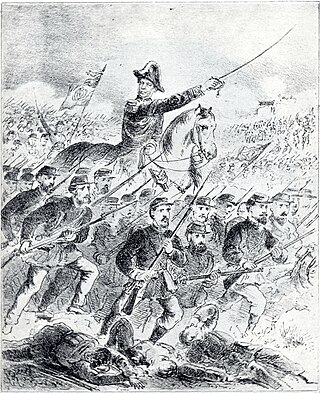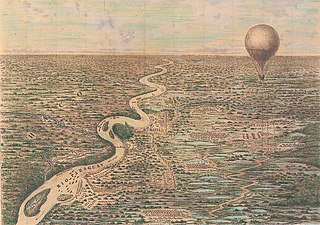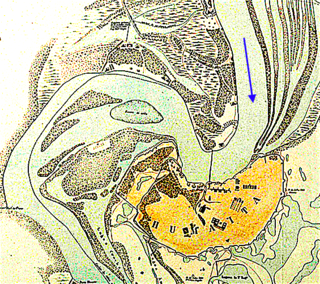
The Paraguayan War, also known as the War of the Triple Alliance, was a South American war that lasted from 1864 to 1870. It was fought between Paraguay and the Triple Alliance of Argentina, the Empire of Brazil, and Uruguay. It was the deadliest and bloodiest inter-state war in Latin American history. Paraguay sustained large casualties, but even the approximate numbers are disputed. Paraguay was forced to cede disputed territory to Argentina and Brazil. The war began in late 1864, as a result of a conflict between Paraguay and Brazil caused by the Uruguayan War. Argentina and Uruguay entered the war against Paraguay in 1865, and it then became known as the "War of the Triple Alliance."

Caazapá is a department in Paraguay. The capital is the city of Caazapá. Among Paraguayans, the department is well known for its orange and mandarin trees, and for its forest hills. The eastern part of Caazapá is relatively undeveloped and consists of rolling hills and large swaths of Brazilian Atlantic interior rainforest between the San Rafael mountains to the south and the Ybytyruzú mountains to the north. The western part is an area of low-lying marshes and swampland area, and consists of wetlands and tributaries to eastern Paraguay's largest river, the Tebicuary. Many indigenous groups make their home in what remains of the rainforest, especially south of the unpaved highway between San Juan Nepomuceno and Tavaí. Mby'a and Guayaki people, who practice farming corn, cassava and yerba mate under the canopy of the forest live in small bands and travel mainly by foot. They are technically protected and their land is a national reserve, but illegal loggers, ranchers, and more recently, Brazilian soybean growers have encroached upon their territory. With Paraguay's weak legal infrastructure, little can be done by way of enforcement or sanctions.

The Battle of Riachuelo was a large and decisive naval battle of the Paraguayan War between Paraguay and the Empire of Brazil. By late 1864, Paraguay had scored a series of victories in the war, but on 11 June 1865, its naval defeat by the Brazilians on the Paraná River began to turn the tide in favor of the allies.

In the Paraguayan War, the Battle of Yatay was fought on August 17, 1865, between the troops of the Triple Alliance and the soldiers of Paraguay near Paso de los Libres, Corrientes, Argentina.

On the morning of 6 December 1868, marshal of the Imperial Brazilian Army, Luís Alves de Lima e Silva, Marquis of Caxias, moved with 16,999 infantrymen, 926 cavalrymen and 742 artillerymen, to take Villeta, a Paraguayan city, as a plan to make further attacks on the Paraguayan Army rear. Nevertheless, Paraguayan president and commander-in-chief of the army Francisco Solano López was aware of the landing the Allies had made in the rear of his army.

The Battle of Cerro Corá was the last battle of the Paraguayan War, fought on 1 March 1870, in the vicinity of Cerro Corá, 454 kilometres (280 mi) northeast of Paraguay's capital Asunción. It is known for being the battle in which Francisco Solano López, Paraguayan president, was killed at the hands of the Imperial Brazilian Army.

The Battle of Estero Bellaco was one of the bloodiest battles of the Paraguayan War. The battle was fought on 2 May 1866 with the Paraguayan Army suffering 2,000 casualties among the dead and wounded. Likewise, 300 of their men were taken prisoner by the troops belonging to the Triple Alliance: Argentina, Brazil and Uruguay. The allies lost nearly 2,000 men, mostly wounded, and the Uruguayan troops of General Venancio Flores - commanded by León de Pallejas - were severely decimated, accounting for the vast majority of allied deaths.

The siege of Humaitá was a military operation in which the Triple Alliance flanked, besieged and captured the Fortress of Humaitá, a Paraguayan stronghold that was referred to as the Gibraltar of South America. It fell on 26 July 1868. It can be considered the key event of the Paraguayan War since the fortress had frustrated the allied advance into Paraguay for more than two years. However it did not surrender as the defenders escaped, most of them to fight another day.

The Battle of Avay of 11 December 1868 was one of the last major combat engagements of the Paraguayan War, fought near the Avay stream in Paraguayan territory between the forces the Triple Alliance and the Paraguayan Army.
Caapucú District is one of the districts of Paraguarí Department, Paraguay.

The Battle of Pehuajó, also known as Battle of Corrales or Battle of Itati was fought during the Paraguayan War on 31 January 1866.

The Fortress of Humaitá (1854–68), known metaphorically as the Gibraltar of South America, was a Paraguayan military installation near the mouth of the River Paraguay. A strategic site without equal in the region, "a fortress the likes of which had never been seen in South America", it was "the key to Paraguay and the upper rivers". It played a crucial role in the deadliest conflict in the continent's history – the Paraguayan War – of which it was the principal theatre of operations.
The Battle of Laguna Sirena took place in the Paraguayan War, on April 17, 1866, close to Paso de Patria, between Brazilians and Paraguayans.

The Battle of Perecué, also known as Battle of Tayí Island, was an armed action that occurred during the Paraguayan War. Paraguayan general Bernardino Caballero's troops launched guerrilla-style raids on the Allied encampment in the Tayí area, near the Humaitá Fortress. The Marquis of Caxias, Luís Alves de Lima e Silva, who had replaced Bartolomé Mitre in the supreme command of allied troops, learned of the Paraguayan presence in the area and prepared a counterattack on his enemies, failing in this action that resulted in a pyrrhic victory of the Paraguayans.

The Manduvirá River Expeditions were the final operations of the Imperial Brazilian Navy carried out on the Paraguayan War. The goal of the imperial fleet was to carry out explorations along the river and its streams, with the aim of capturing or destroying the remaining ships of the Paraguayan armada that had taken refuge. The Brazilian fleet was composed of eighteen ships, including battleships, monitors, gunboats and steamboats while the Paraguayan fleet had about a dozen steamers. A total of three expeditions were carried out, which proved to be extremely dangerous for Brazilian ships due to the sinuosity of the river and the blockades created by the Paraguayans.

The Corrientes campaign or the Paraguayan invasion of Corrientes was the second campaign of the Paraguayan War. Paraguayan forces occupied the Argentinian city of Corrientes and other towns in Corrientes Province. The campaign occurred at the same time as the Siege of Uruguaiana.

The Humaitá campaign or the Cuadrilátero campaign was the third, longest and deadliest campaign of the Paraguayan War. The campaign lasted from 16 April 1866 to 5 August 1868. After the initial Paraguayan success in the Mato Grosso campaign and its failure in the Corrientes campaign, the armed forces of the Triple Alliance, Argentina, the Empire of Brazil and Uruguay, invaded the south of Paraguay. At a very short distance, they found the Paraguayan defensive device made up of four fortifications, the so-called "Cuadrilátero", which obstructed the passage to Asunción both by land and by the Paraguay River. A long series of battles cost huge numbers of casualties on both sides, with operations coming to a complete halt after the allied defeat at the Battle of Curupayty. Casualties on both sides were even higher from disease than from battle due to a cholera epidemic which was added to the appalling food and sanitary conditions.

The Invasion of Rio Grande do Sul began on June 10, 1865 when about 7,500 soldiers under the command of General Antonio de la Cruz Estigarribia invaded the village of São Borja near Brazil's border with Argentina. About 3,000 men commanded by major Pedro Duarte stayed on the other side of the Uruguay River to accompany the advance of the main column. The Paraguayans always advanced along the river without major damage, with the exception of a confrontation on the Butuí River where a Paraguayan battalion had been defeated, until they reached Uruguaiana, where a two-month siege made them surrender unconditionally on September 18. The main objective of Paraguayan president Francisco Solano López to invade Rio Grande do Sul was to force a peace treaty favorable to the Paraguayans with the Empire of Brazil. The action took place in the second phase of the Paraguayan War, known as the Corrientes campaign.

The assault on the battleship Barroso and the monitor Rio Grande, also known as assault on the battleships at Tagy, was a Paraguayan naval operation carried out during the Paraguayan War. The Imperial Brazilian Navy was present in the main actions of the allied forces. President Francisco Solano López knew of the threat that the navy posed and wanted to capture some of its ships, the ironclads. The seizure was also seen as a form of compensation for the losses incurred as a result of the war. Assault plans were created and executed in 1868.

The Passage of Fortín Island consisted of the transposition carried out by a naval division of the Imperial Brazilian Navy - consisting of the ironclads Bahia and Silvado, and the monitor Alagoas - against a Paraguayan fortified position located near the Fortress of Humaitá called Fortín Island, on the banks of the Paraguay River, on 24 July 1868, during the Paraguayan War. The passage was successfully completed, even under fire from the fortifications. At night, the Paraguayans left Fortín Island to Acayuazá and Isla Poí.

















